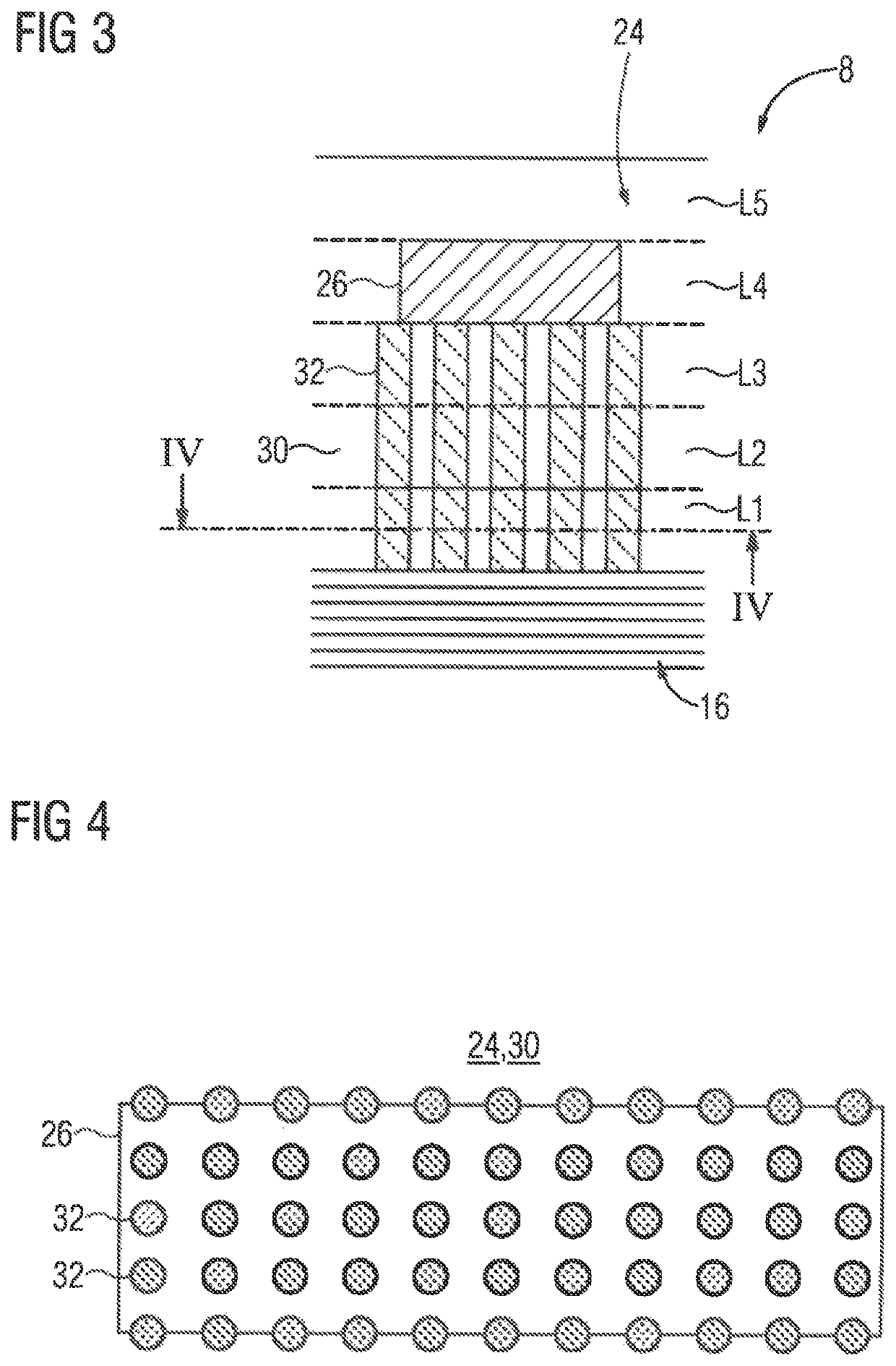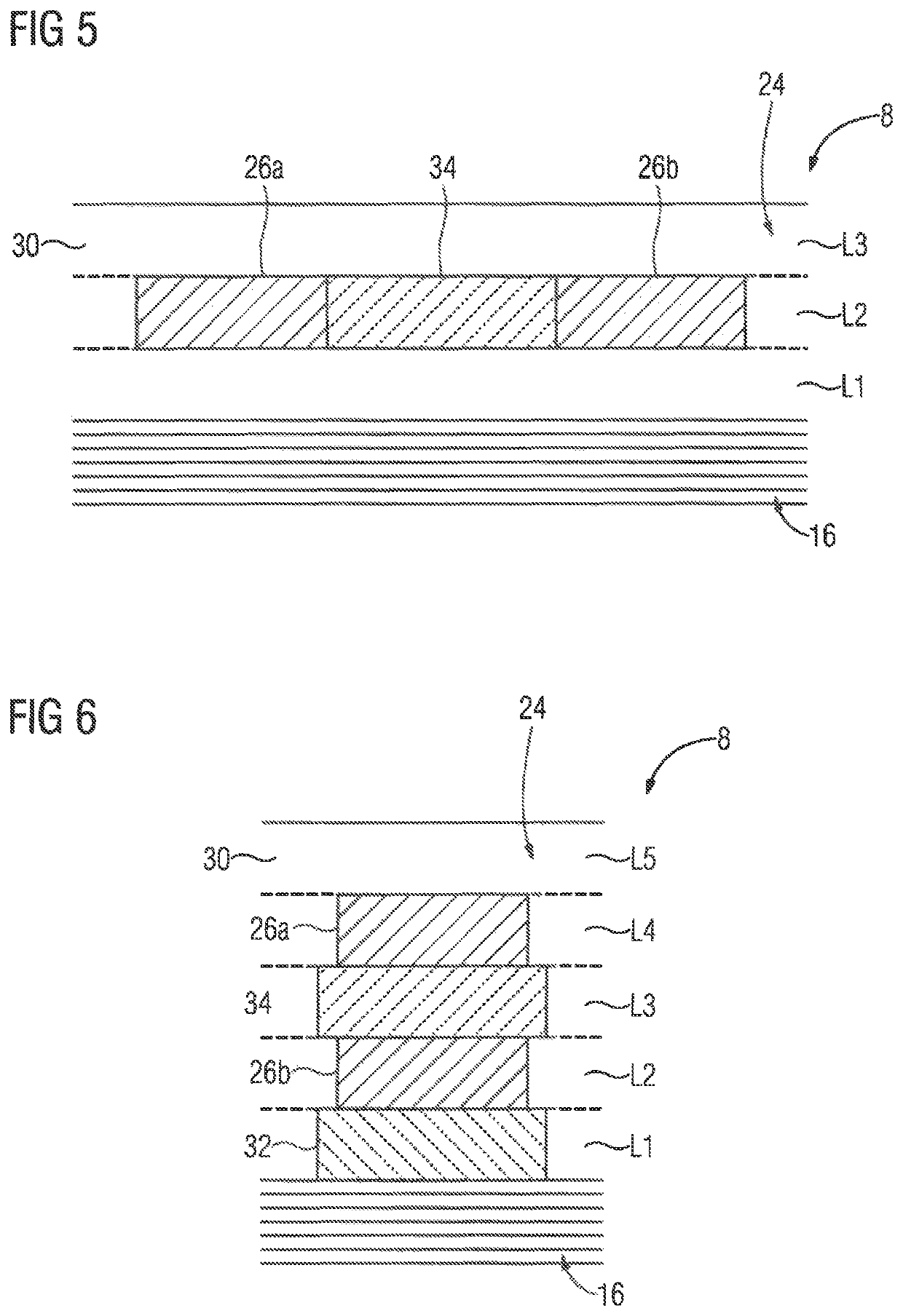Stator for a rotating electric machine having dielectric regions for a winding head board
a technology of dielectric regions and winding heads, which is applied in the direction of windings, winding insulation materials, cooling/ventilation arrangements, etc., to achieve the effects of reducing the space requirement improving the heat removal effect of the winding head board, and improving the thermal conductivity
- Summary
- Abstract
- Description
- Claims
- Application Information
AI Technical Summary
Benefits of technology
Problems solved by technology
Method used
Image
Examples
first embodiment
[0044]FIG. 2 shows an enlarged longitudinal section through a stator 8 of an electrical rotating machine 2 in the region of the winding head board 24 which is constructed, by way of example, from five layers L1, L2, L3, L4, L5. The thickness D of the entire winding head board 24 lies in the centimeter range, in particular in the range of from 3 to 10 cm. The first layer L1 of the winding head board 24 rests on the stator laminated core 15, so that the winding head board 24 is thermally connected to the stator laminated core 16. The topmost, by way of example fifth, layer L5 is optionally thermally connected to a further metal surface, for example a machine housing 15 which is illustrated in FIG. 1, so that the winding head board 24 is additionally thermally connected to the machine housing 15.
[0045]A conductor track 26 runs in the second layer L2. The layers L1, L2, L3, L4, L5 of the winding head board 24 are produced for the most part from a first dielectric material 30. In particu...
second embodiment
[0049]FIG. 3 shows an enlarged longitudinal section through a stator 8 of an electrical rotating machine 2 in the region of the winding head board 24. By way of example, a conductor track 26 is arranged in the fourth layer L4 of the winding head board 24. The region comprising the second dielectric material 32 is structured, in particular in the form of a plurality of, for example identical, pillars, arranged between the conductor track 26 and the stator laminated core 16, and constitutes, owing to the higher thermal conductivity and lower strength of the second dielectric material 32 in comparison to the first dielectric material 30, an optimum balance between thermal connection of the conductor track 26 to the stator laminated core 16 and strength of the winding head board 24. The further design of the stator 8 corresponds to the design in FIG. 2.
[0050]FIG. 4 shows an enlarged cross section through the second embodiment of the stator 8 in the region of the winding head board 24. T...
third embodiment
[0051]FIG. 5 shows an enlarged longitudinal section through a stator 8 of an electrical rotating machine 2 in the region of the winding head board 24 which has three layers L1, L2, L3. By way of example, two conductor tracks 26a, 26b run in the central, second layer L2. A region comprising a third dielectric material 34, which has a higher dielectric strength than the first dielectric material 30, is likewise located in the second layer between the two conductor tracks 26a, 26b. In particular, the third dielectric material 34 is embodied as a ceramic material. As an alternative, the third dielectric material 34 is embodied as a plastic with a high dielectric strength. Owing to the increased dielectric strength in the region between the two conductor tracks 26a, 26b, it is possible to reduce the distance between the conductor tracks. The further design of the stator 8 corresponds to the design in FIG. 2.
PUM
 Login to View More
Login to View More Abstract
Description
Claims
Application Information
 Login to View More
Login to View More - R&D
- Intellectual Property
- Life Sciences
- Materials
- Tech Scout
- Unparalleled Data Quality
- Higher Quality Content
- 60% Fewer Hallucinations
Browse by: Latest US Patents, China's latest patents, Technical Efficacy Thesaurus, Application Domain, Technology Topic, Popular Technical Reports.
© 2025 PatSnap. All rights reserved.Legal|Privacy policy|Modern Slavery Act Transparency Statement|Sitemap|About US| Contact US: help@patsnap.com



